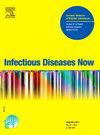Treatment of left-sided prosthetic valve endocarditis by suppressive antibiotic therapy: A retrospective monocentric real-world study
IF 2.2
4区 医学
Q2 INFECTIOUS DISEASES
引用次数: 0
Abstract
Objectives
Prosthetic valve endocarditis has a poor prognosis, with high risks of relapse complicating management. Suppressive antibiotic therapy is increasingly considered as a means of treatment for infected devices that cannot be removed. We compared i) early mortality and ii) one-year overall and relapse-free survival between different strategies in real-world management of prosthetic valve endocarditis, one of them being suppressive antibiotic therapy.
Patients and methods
This single-center retrospective study included patients with aortic or mitral prosthetic valve endocarditis managed between 2019 and 2021. Each strategy was patient-centered and decided on by a multidisciplinary team. At first, we divided the population between surgically and conservatively managed patients. Initial intravenous antibiotic therapy lasted at least six weeks, and we compared early mortality having occurred prior to its completion. At a later stage, we divided the conservatively managed survivors between those who received suppressive antibiotic therapy and those who did not, and we compared survival and relapse rates during the first year subsequent to adaptation of each strategy.
Results
Seventy-five patients were included. Biological prostheses (33 %) for aortic valve replacement (95 %) predominated. The 17 (22.3 %) surgically managed patients were younger. Among the 58 conservatively managed patients, 42 had a theoretical indication for surgery. Eleven (14.6 %) patients died before having completed their course of intravenous antibiotic therapy, with no difference between surgical and conservative strategies (17.6 % vs. 13.8 %, p = 0.7043). Out of the 50 conservatively managed survivors, 35 received suppressive antibiotic therapy. Overall one-year survival was 73.9 % [64.1–85.2] and did not differ from one strategy to the next. Only six relapses occurred within the first year, including one (7.1 %) in surgically managed survivors and two (5.6 %) among the conservatively managed survivors receiving suppressive antibiotic therapy (5.6 %).
Conclusions
While surgery remains the gold standard for prosthetic valve endocarditis, especially in complicated cases, suppressive antibiotic therapy appeared suitable for selected patients for whom the surgical option seemed excessively risky.
抑制抗生素治疗左侧人工瓣膜心内膜炎:一项回顾性单中心真实世界研究。
目的:人工瓣膜心内膜炎预后差,复发率高。抑制性抗生素治疗越来越被认为是一种治疗无法移除的感染装置的手段。我们比较了i)早期死亡率和ii)人工瓣膜心内膜炎不同治疗策略的一年总生存率和无复发生存率,其中一种是抑制抗生素治疗。患者和方法:这项单中心回顾性研究纳入了2019年至2021年间治疗的主动脉瓣或二尖瓣心内膜炎患者。每个策略都以患者为中心,并由一个多学科团队决定。首先,我们将患者分为手术治疗和保守治疗两组。最初的静脉注射抗生素治疗持续至少6周,我们比较了治疗完成前发生的早期死亡率。在后期,我们将保守治疗的幸存者分为接受抑制性抗生素治疗和未接受抑制性抗生素治疗的幸存者,并比较了适应每种策略后第一年的生存率和复发率。结果:纳入75例患者。生物假体(33 %)在主动脉瓣置换术中占主导地位(95 %)。17例(22.3% %)手术治疗的患者年龄较小。在58例保守治疗的患者中,42例理论上有手术指征。11例(14.6 %)患者在完成静脉抗生素治疗疗程前死亡,手术和保守策略之间没有差异(17.6 %对13.8 %,p = 0.7043)。在50例保守治疗的幸存者中,35例接受了抑制性抗生素治疗。总的一年生存率为73.9 %[64.1-85.2],不同的治疗策略之间没有差异。只有6例复发发生在第一年,包括1例(7.1 %)手术治疗的幸存者和2例(5.5.6 %)保守治疗接受抑制抗生素治疗的幸存者(5.6% %)。结论:虽然手术仍然是治疗人工瓣膜心内膜炎的金标准,特别是在复杂的病例中,但对于那些手术选择风险过大的患者来说,抑制性抗生素治疗似乎是合适的。
本文章由计算机程序翻译,如有差异,请以英文原文为准。
求助全文
约1分钟内获得全文
求助全文
来源期刊

Infectious diseases now
Medicine-Infectious Diseases
CiteScore
7.10
自引率
2.90%
发文量
116
审稿时长
40 days
 求助内容:
求助内容: 应助结果提醒方式:
应助结果提醒方式:


